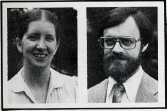 |
Home | Search | Browse | About IPO | Staff | Links |
 |
Home | Search | Browse | About IPO | Staff | Links |

By BARBARA J. HIPSMAN BOB SPRINGER Looking down on Chicago WHEN Chicago Sun-Times columnist Mike Royko rapped out a series of scathing, anti-downstate pieces last spring, he also rapped open a hornet's nest of anti-Chicago bias that has been ripening for years. It wasn't so much that downstate politicos took Royko seriously when he branded all down-staters as "boobs" and "bumpkins," as much as they realized that down-staters finally could sting Chicago Democrats. The pendulum of legislative power has shifted and the loose coalition of suburban and collar county Republicans, and of Democrats and Republicans from the rest of Illinois cannot be ignored. Downstate members of the General Assembly did not, of course, agree with Royko's vitriolic attacks against forces "out to get Chicago." Rather, Royko's polemics were seen as an admission (and a whining one at that) that Chicago could no longer use its big shoulders in the legislature to force the rest of the state to cower before the city and its expensive needs. Royko forced to the surface again feelings that can be traced to the Civil War, when Chicago was budding as a commercial, urban center and many of its leading citizens feared the slavery-sympathizing, Southern Democrats of rural Illinois. The Chicago area's mass transit crisis was the issue that opened the north-south rift again. But it also was the coagulant that allowed downstate leaders to stem what they considered to be the bleeding of the state's financial veins. The mass transit issue elicited all the simplistic archetypes again — urban versus rural, tax "eater" versus taxpayer and streetwise machine politico versus dim-witted county fair circuit rider. Such two-dimensional arguments may have obscured more important, subtle tensions underpinning Illinois' political system. Nevertheless, they offered a rallying point and underlined the decline of Chicago as a political powerhouse. It's not just that Richard J. Daley is no longer exercising his iron grip over a political system; it isn't only that downstaters have learned to play politics the way city folks play; it isn't merely that the nation is in tough economic straits. Chicago's lurching mass transit struggle showed clearly what has been slowly occurring over years: A leveling of what was once the great peak of Chicago political power. But "downstate" Illinois, as any native or immigrant to it knows, defies easy generalizations. It is a land of economic, political and social diversity. Because it is defined easily geographically, downstate Illinois is often thought to be easy to define in other ways. But perceptions of it, especially by outsiders, are often far afield. And it is such skewed perceptions that provide the basis for such stereotypical views as come from Mike Royko. Royko is a humorist, of course, and his columns often provide more in the way of laughs than insights. Traditionally, downstate has been everything outside of Cook County. Just as darkness is the absence of light, downstate is simply the absence of Chicago — to those who have never spent time there, Royko for one. Geographically, the division makes no sense to someone living in Waukegan. And with tremendous population shifts away from Chicago and into suburban 2 | October 1981 | Illinois Issues Cook County and the surrounding collar counties of DuPage, Kane, Lake, McHenry and Will, the technical definition fails to adequately describe — politically, economically or geographically — downstate in the 1980s. If we assume that physical environment plays a role in fixing social and political characteristics, then central Illinois, dominated in summer by corn and soybeans and in winter by miles of rich, dark earth, should hardly be lumped with deep southern Illinois. This area of the state is sparsely populated, rolls with Appalachian-like hills, and contains the beautiful Shawnee National Forest. The crowded poverty of East St. Louis is stark when contrasted to the sturdy, professorial dignity of neighborhoods surrounding Urbana's University of Illinois. The blue-collar, middle class of Moline and Rock Island are another planet to the "river rat" subsistence of some in Hardin and Pope counties. Yet politically, they are all downstate. When candidates forage for votes in the 96 counties not part of Illinois' northeastern, 24-hour-a-day rush hour, they usually cajole the audience with what is a pledge and a plea: "A vote for me is a vote against Chicago." Politically dividing Illinois into three such identifiable sectors — city, suburb and downstate — undoubtedly leads to policies that are a disservice to each area. But after watching the suburban and downstate armies launch a unified assault against Chicago in last spring's mass transit battle, and the cocky gloating with which some generals of the new, legislative army relished their victory, most downstaters surely feel that an imbalance in their favor in years ahead merely will even the score from the losses of the past. "Politics" will now appear each month in Illinois Issues. Bob Kieckhefer will continue to author the column every other month, and the husband and wife team of Barbara J. Hipsman and Bob Springer will author the column in alternate months. Hipsman is Statehouse bureau chief for the News-Democrat of Belleville, and Springer is a Statehouse reporter for The Associated Press. Kieckhefer is Illinois editor for United Press International in Chicago. October 1981 | Illinois Issues | 3 |
|
|